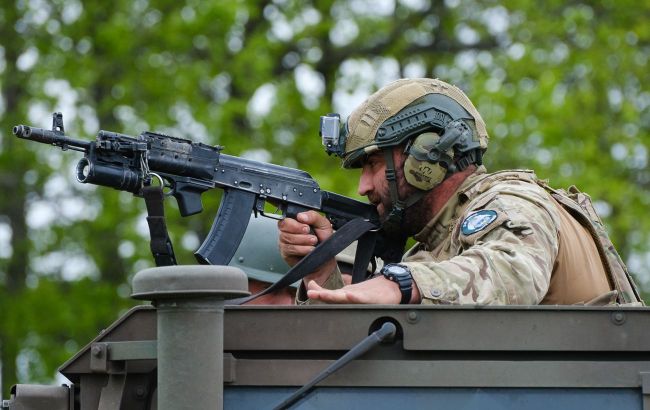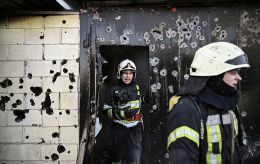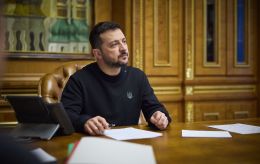Armed Forces offensive on different directions prevents Russia from forming new forces - ISW
 Ukrainian Armed Forces counteroffensive thwarts Russian attempts to create new forces (Photo: RBC-Ukraine, Vitalii Nosach)
Ukrainian Armed Forces counteroffensive thwarts Russian attempts to create new forces (Photo: RBC-Ukraine, Vitalii Nosach)
Analysts from the Institute for the Study of War (ISW) concluded that simultaneous Ukrainian counteroffensive operations in the Bakhmut region and the south of the country prevented Russian occupiers from forming additional forces, according to the report by ISW.
The publication references a statement by Russian Defense Minister Sergei Shoigu, indicating that his ministry formed a "reserve army" at the end of June. Experts suggest that among the units Shoigu was likely referring to was the 25th Combined Arms Army (CCA), which began recruiting personnel from the Far East in mid-May.
The formation of this 25th CCA was likely part of Shoigu's announced intention to carry out a large-scale restructuring of forces by 2026. Using these forces in combat and defensive operations could lead to the depletion of reserves intended for the long-term renewal and expansion of Russia's Armed Forces, as stated in the report.
"The Russian military command probably also couldn't fully equip or properly train the 25th Combined Arms Army at this time," said Institute for the Study of War experts.
The Chief of the Defense Intelligence of Ukraine, Kyrylo Budanov, previously clarified that the incomplete 25th Army consists of about 15,000 service members. At the same time, the Russian military reportedly aimed to recruit 30,000 contract soldiers, ISW highlighted.
According to Ukrainian military estimates, the 25th Division of the Southern Military District is not expected to be combat-ready until at least 2024.
Russia previously attempted to form the 3rd Army Corps as reserve forces in the summer of 2022. However, the report adds that in the fall of 2022, it was deployed and expended most of this poorly trained formation while defending against Ukrainian counteroffensives.
Key Findings:
- ISW now assesses that Ukrainian Armed Forces have breached Russian field fortifications west of Verbove in the Western Zaporizhzhia region.
- Ukrainian forces have not fully cleared prepared Russian defensive positions near Verbove.
- Ukrainian forces are deepening their penetration into the Zaporizhzhia region and are attacking Novoprokopivka, a front-line village 1.5 km south of Robotyne.
- Ukrainian military states that the counteroffensive will continue through the winter.
- The Ukrainian counteroffensive in the Zaporizhzhia region likely destroyed the Russian 810th Marine Brigade (Black Sea Fleet).
- The direct statement from Ukraine's high-ranking military officer confirms that Ukraine's goal in Bakhmut is to encircle Russian forces. Maintaining Russian forces in Bakhmut may reduce pressure on the front line in Kupiansk.
- Simultaneous Ukrainian counteroffensives in Bakhmut and in the south of Ukraine hinder Russia's long-term efforts to form forces as they must reallocate their new reserves to fend off the Ukrainian advance.
- The head of Ukrainian intelligence reported that on September 22, a strike by the Ukrainian Defense Forces on the Russian Black Sea Fleet command post in occupied Sevastopol wounded high-ranking Russian commanders.
- Russian forces conducted a series of missile and drone strikes on Ukraine on September 22-23 night.
- The occupation "governor" of the Zaporizhzhia region, Yevhen Balytskyi, appointed former head of Roscosmos and ultranationalist Dmitry Rogozin as a "senator" to the Federation Council from the occupied part of the Zaporizhzhia region of Ukraine.
- A Russian insider source claimed that Russian military personnel would reintegrate political officers to address political and ideological issues among military personnel – a problem Russian military "thinkers" identified in September 2018.
- Disparate elements of the Wagner Private Military Company reportedly returning to fight in Ukraine will likely affect Russian military capabilities without providing the same effectiveness Wagnerites had as a unified organization under Yevgeny Prigozhin's leadership and Dmitry Utkin's founding.
- Russian forces conducted offensive operations along the Kupiansk – Svatove – Kremenna line, near Bakhmut, along the Avdiivka – Donetsk line, in western Donetsk region, along the western and eastern borders of Zaporizhzhia region, and in west Zaporizhzhia part but failed to achieve success on September 23.
- The Russian government is looting funds from military facilities near the border with Ukraine.
- Russian government programs continue to deport children from the occupied territories of Ukraine forcibly.
Advancements around Bakhmut and in the south
Ukrainian forces continue their offensive actions in the Bakhmut direction and have already established fire control over the Bakhmut-Horlivka highway. According to the spokesperson of the Eastern Military Group of the Ukrainian Armed Forces, Illia Yevlash, this has significantly complicated the logistics of Russian forces.
The General Staff reported that on September 23, Ukrainian defenders continued their advance in Verbove in the Zaporizhzhia region and pushed the enemy out of their previously held positions.
Earlier, the commander of the Tavria Operational Strategic Group, Oleksandr Tarnavsky, stated that the most significant breakthrough in this counteroffensive would occur when Ukrainian forces reached Tokmak in the Zaporizhzhia region.
Estonian military intelligence reports that the Russian Federation has relocated units to the Tokmak area from other parts of the front as occupiers prepare for the city's defense.
Meanwhile, British intelligence suggests that, in light of the success of Ukrainian defenders in the south, the occupiers may strengthen their offensive toward Kupiansk-Lyman. Ukrainian military sources have noted that the Russians attempted to form a strike force but lacked the necessary equipment.

